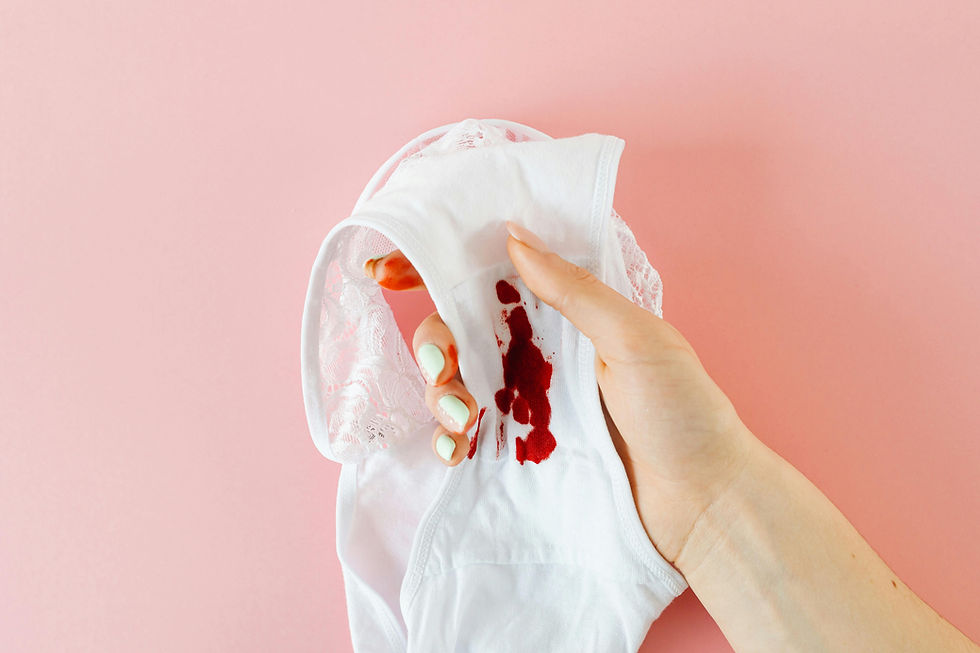Free Bleeding and Period Poverty: Sustainable Alternatives for Conscious Menstruation
- Fabiana Chumaceiro
- Aug 26
- 3 min read
Discover what free bleeding is, how to practice it safely, and how it relates to period poverty and the fight for menstrual rights.
Access to Menstrual Management and New Alternatives
Access to menstrual management has historically been conditioned by factors such as socioeconomic status and cultural context.
This is why new alternatives have emerged, aiming to close these gaps while reducing the environmental impact of conventional disposable products like sanitary pads.
Among these alternatives is free bleeding, a practice that allows a deeper connection with our bodies and cycles. And although it may sound new, it is actually very ancient.
What Is Free Bleeding and Who Practices It?
Free bleeding means menstruating intentionally without collecting the blood using pads, tampons, or cups.
It can be practiced in different ways:
Using cloths or towels on surfaces to absorb the blood.
Bleeding freely into clothing set aside for that purpose.
Using menstrual underwear designed to absorb flow.
Paying attention to body signals to release blood directly into the toilet, similar to urination.
Although we’ve been told that menstruation is like an “open tap,” in reality menstrual flow is intermittent, and with practice, you can learn to better control when to release blood.
Activism and Rights: Beyond the Practice
Free bleeding is also seen as a form of activism:
It reclaims lived experiences around menstruation.
It raises awareness about period poverty and the high cost of menstrual products.
It challenges the environmental impact of disposables.
👉 In the United States alone, menstruating people throw away nearly 2 kilos of menstrual products each year.
It can also be useful for:
People with disabilities, for whom changing products frequently is difficult.
People with sensitive skin who experience irritation from long-term use of pads.
Reconnecting With the Body and Breaking Myths
For many, free bleeding is a way to reconnect with the body and dismantle common myths about menstruation, such as:
Menstrual blood is dirty.
It always smells bad.
The volume of menstrual blood is extremely large.

In reality, these myths are reinforced by disinformation and the chemicals in conventional products, which, when mixed with oxygen and blood, create unpleasant odors.
When and How to Practice Free Bleeding
Every person decides when to practice free bleeding:
Throughout the entire period, regardless of flow.
During specific moments (e.g., at night or at home).
In the final days, when flow is lighter.
Practical Recommendations
Start at home to get used to your body’s rhythm.
Combine it with menstrual underwear for extra comfort.
Change underwear every 12 hours maximum and wash it thoroughly.
Period Poverty: An Urgent Reality
For many, free bleeding is not a choice but a consequence of period poverty.
Period poverty means lack of:
Access to menstrual hygiene products.
Adequate sanitation (clean water, toilets, waste management).
Basic education about menstrual health.
In Venezuela, a 2020 study by AVESA found that:
9 out of 10 women experience period poverty.
4 out of 10 cannot buy menstrual hygiene products.
5 out of 10 lack access to absorbent products.
60% resort to homemade alternatives or share products.
Menstrual Health and Safety in Free Bleeding
Free bleeding is safe, but it’s important to keep in mind:
Menstrual blood may contain viruses such as HIV or hepatitis; it should not be shared without consent.
Avoid letting blood rest on the skin for long periods.
Use breathable fabrics to protect sensitive skin.
Change clothes frequently if flow is heavy.
Listening to the Body: The Art of Free Bleeding
A key part of free bleeding is learning to recognize your body’s signals:
Some people feel subtle contractions when the cervix opens.
Others sense a tingling that means blood is descending.
With practice, it becomes easier to distinguish this from the need to urinate.
Useful Exercises
Do Kegel exercises to strengthen the pelvic floor.
Use a mirror to observe vaginal muscle contractions and relaxation.
Practice yoga, pilates, or dance styles that tone the pelvic area.
Free bleeding is not only a menstrual practice but also a political and conscious act against period poverty and misinformation.
Every body is unique, and the most important thing is to have safe, accessible, and sustainable options for all menstruating people.
If you have questions about your sexual and reproductive health, you can find evidence-based, WHO-backed resources and peer support in the Aya Contigo app.
Author: Fabiana Chaumaceiro, member of YAC team Venezuela
🔎 Download the Aya Contigo app or access it directly from your browser to get reliable information and connect with other young people in a safe space.




Comments